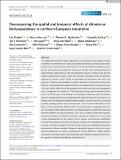Decomposing the spatial and temporal effects of climate on bird populations in northern European mountains
Abstract
The relationships between species abundance or occurrence versus spatial variation in climate are commonly used in species distribution models (SDMs) to forecast future distributions. Under "space-for-time-substitution", the effects of climate variation on species are assumed to be equivalent in both space and time. Two unresolved issues of space-for-time-substitution are the time period for species' responses and also the relative contributions of rapid- versus slow reactions in shaping spatial and temporal responses to climate change. To test the assumption of equivalence, we used a new approach of climate decomposition to separate variation in temperature and precipitation in Fennoscandia into spatial, temporal and spatio-temporal components over a 23-year period (1996-2018). We compiled information on land cover, topography and six components of climate for 1756 fixed route surveys and we modelled annual counts of 39 bird species breeding in the mountains of Fennoscandia. Local abundance of breeding birds was associated with the spatial components of climate as expected, but the temporal and spatio-temporal climatic variation from the current and previous breeding seasons were also important. The directions of the effects of the three climate components differed within and among species, suggesting that species can respond both rapidly and slowly to climate variation and that the responses represent different ecological processes. Thus, the assumption of equivalent species' response to spatial and temporal variation in climate was seldom met in our study system. Consequently, for the majority of our species, space-for-time substitution may only be applicable once the slow species' responses to a changing climate have occurred. Whereas forecasts for the near future need to accommodate the temporal components of climate variation. However, appropriate forecast horizons for space-for-time substitution are rarely considered and may be difficult to reliably identify. Accurately predicting change is challenging because multiple ecological processes affect species distributions at different temporal scales.
Citation
Bradter , U , Johnston , A , Hochachka , W M , Soultan , A , Brommer , J E , Gaget , E , Kålås , J A , Lehikoinen , A , Lindström , Å , Piirainen , S , Pavón-Jordán , D , Pärt , T , Øien , I J & Sandercock , B K 2022 , ' Decomposing the spatial and temporal effects of climate on bird populations in northern European mountains ' , Global Change Biology , vol. Early View . https://doi.org/10.1111/gcb.16355
Publication
Global Change Biology
Status
Peer reviewed
ISSN
1354-1013Type
Journal article
Description
Funding: The Swedish Bird Survey was supported by grants from the Swedish Environmental Protection Agency, with additional financial and logistic support from the Regional County Boards (Länsstyrelsen). The surveys were carried out within the framework of the strategic research environment Biodiversity and Ecosystem Services in a Changing Climate (BECC). The Norwegian breeding bird monitoring (Norsk hekkefuglovervåking) was financed by the Norwegian Environment Agency and the Ministry of Climate and Environment. Our research was funded through the 2017-2018 Belmont Forum and BiodivERsA joint call for research proposals, under the BiodivScen ERA-Net COFUND programme with financial support from the Research Council of Norway (295767), the Swedish Research Council FORMAS (2018-02440, 2018-02441), the Academy of Finland (323527, 326327, 326338) and the U.S. National Science Foundation (ICER-1927646).Collections
Items in the St Andrews Research Repository are protected by copyright, with all rights reserved, unless otherwise indicated.
Related items
Showing items related by title, author, creator and subject.
-
Macroeconometric forecasting in developing countries with special reference to fiscal policy : a case study of India
Srivastava, Dinesh Kumar (University of St Andrews, 1979) - ThesisThis work was undertaken with a view to construct a macroeconometric model for the Indian economy for purposes of forecasting and policy simulation. As a prelude to this exercise, we have surveyed available forecasting ... -
Essays on volatility forecasting
Kambouroudis, Dimos S. (University of St Andrews, 2012-06-22) - ThesisStock market volatility has been an important subject in the finance literature for which now an enormous body of research exists. Volatility modelling and forecasting have been in the epicentre of this line of research ... -
Econometric forecasting of financial assets using non-linear smooth transition autoregressive models
Clayton, Maya (University of St Andrews, 2011-06-23) - ThesisFollowing the debate by empirical finance research on the presence of non-linear predictability in stock market returns, this study examines forecasting abilities of nonlinear STAR-type models. A non-linear model methodology ...

